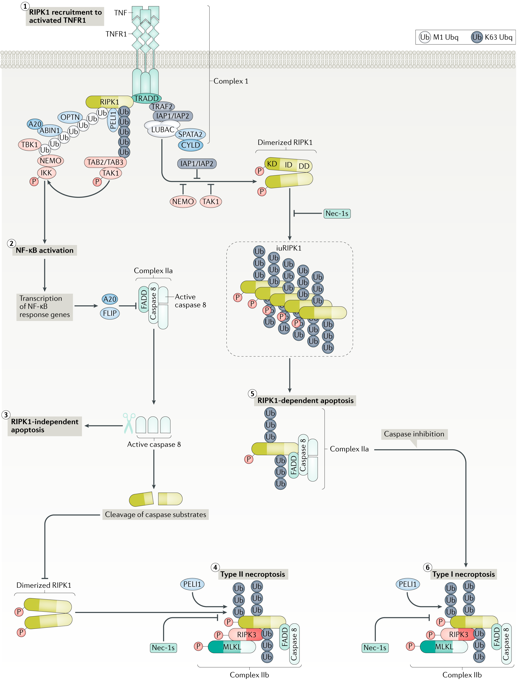当前位置:
X-MOL 学术
›
Nat. Rev. Neurosci.
›
论文详情
Our official English website, www.x-mol.net, welcomes your
feedback! (Note: you will need to create a separate account there.)
Necroptosis and RIPK1-mediated neuroinflammation in CNS diseases.
Nature Reviews Neuroscience ( IF 28.7 ) Pub Date : 2019-01-01 , DOI: 10.1038/s41583-018-0093-1
Junying Yuan 1 , Palak Amin 1 , Dimitry Ofengeim 2
Nature Reviews Neuroscience ( IF 28.7 ) Pub Date : 2019-01-01 , DOI: 10.1038/s41583-018-0093-1
Junying Yuan 1 , Palak Amin 1 , Dimitry Ofengeim 2
Affiliation

|
Apoptosis is crucial for the normal development of the nervous system, whereas neurons in the adult CNS are relatively resistant to this form of cell death. However, under pathological conditions, upregulation of death receptor family ligands, such as tumour necrosis factor (TNF), can sensitize cells in the CNS to apoptosis and a form of regulated necrotic cell death known as necroptosis that is mediated by receptor-interacting protein kinase 1 (RIPK1), RIPK3 and mixed lineage kinase domain-like protein (MLKL). Necroptosis promotes further cell death and neuroinflammation in the pathogenesis of several neurodegenerative diseases, including multiple sclerosis, amyotrophic lateral sclerosis, Parkinson disease and Alzheimer disease. In this Review, we outline the evidence implicating necroptosis in these neurological diseases and suggest that targeting RIPK1 might help to inhibit multiple cell death pathways and ameliorate neuroinflammation.
中文翻译:

中枢神经系统疾病的坏死病和RIPK1介导的神经炎症。
细胞凋亡对于神经系统的正常发育至关重要,而成年中枢神经系统中的神经元对这种细胞死亡具有相对的抵抗力。然而,在病理条件下,死亡受体家族配体的上调,例如肿瘤坏死因子(TNF),可使中枢神经系统中的细胞对细胞凋亡和一种受调节的坏死性细胞死亡形式(称为坏死病)敏感,这种坏死由受体相互作用蛋白激酶介导1(RIPK1),RIPK3和混合谱系激酶域样蛋白(MLKL)。坏死病在几种神经退行性疾病的发病机理中进一步促进细胞死亡和神经炎症,包括多发性硬化症,肌萎缩性侧索硬化症,帕金森氏病和阿尔茨海默氏病。在这篇评论中,
更新日期:2019-01-26
中文翻译:

中枢神经系统疾病的坏死病和RIPK1介导的神经炎症。
细胞凋亡对于神经系统的正常发育至关重要,而成年中枢神经系统中的神经元对这种细胞死亡具有相对的抵抗力。然而,在病理条件下,死亡受体家族配体的上调,例如肿瘤坏死因子(TNF),可使中枢神经系统中的细胞对细胞凋亡和一种受调节的坏死性细胞死亡形式(称为坏死病)敏感,这种坏死由受体相互作用蛋白激酶介导1(RIPK1),RIPK3和混合谱系激酶域样蛋白(MLKL)。坏死病在几种神经退行性疾病的发病机理中进一步促进细胞死亡和神经炎症,包括多发性硬化症,肌萎缩性侧索硬化症,帕金森氏病和阿尔茨海默氏病。在这篇评论中,































 京公网安备 11010802027423号
京公网安备 11010802027423号